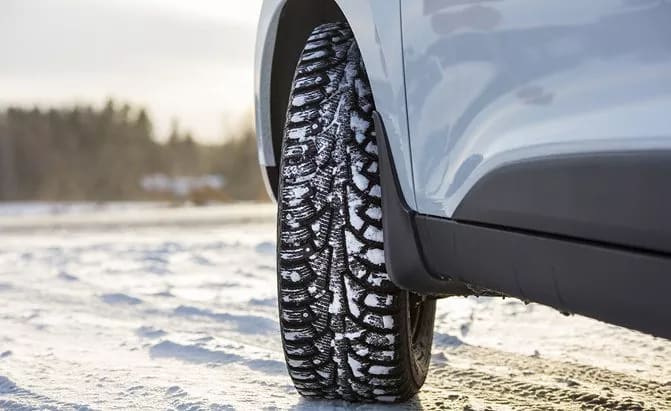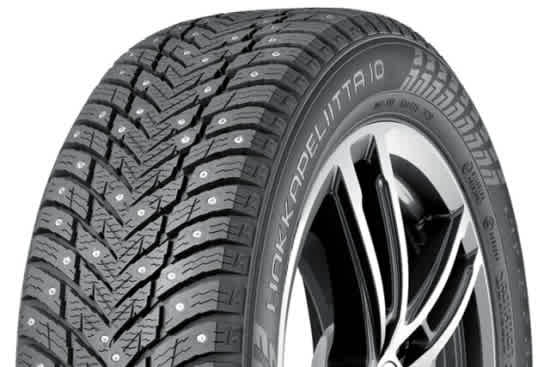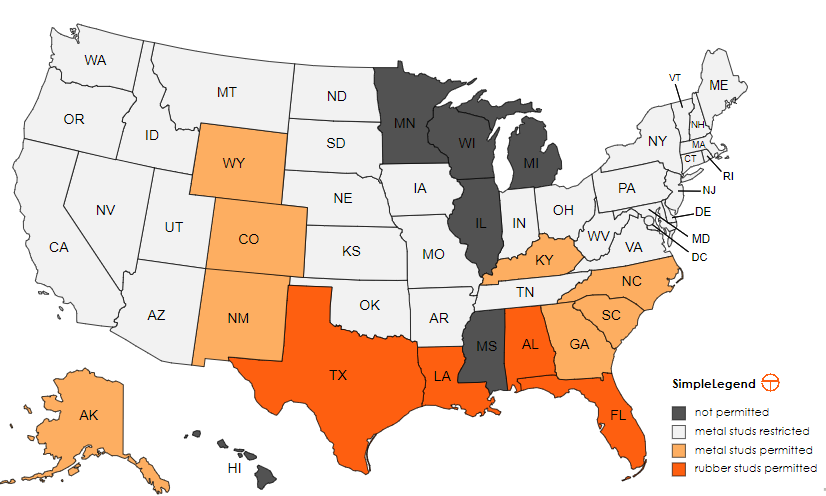Tire Buying Guides
Free shipping
Best price guarantee
Special pricing
Financing with Resolve
Easy returns

Winter driving demands serious attention to tire selection, especially when ice transforms roads into treacherous skating rinks. Metal-studded tires represent one of the oldest solutions for extreme winter traction, yet many drivers remain uncertain about their true value.
The debate between studded and studless winter tires intensifies each fall as temperatures drop and road conditions deteriorate. Modern tire technology has evolved dramatically, but studded tires maintain a dedicated following among drivers who face the harshest winter conditions.
Understanding whether studded tires suit your specific needs requires examining their unique construction, performance characteristics, and the regulations that govern their use. This comprehensive analysis will help you determine if the extra grip—and extra considerations—make studded tires worthwhile for your winter driving situation.
What Are Studded Tires?
Understanding the Basics
Studded tires represent a specialized category of winter tires engineered with small metal spikes embedded directly into the tread rubber. These lightweight studs—typically made from tungsten carbide or steel—protrude approximately 1/32 to 5/32 of an inch from the tire surface, creating hundreds of tiny contact points designed to penetrate ice and hard-packed snow.
The manufacturing process requires precise engineering: each stud must be positioned strategically across the tread pattern to maximize ice grip while maintaining tire integrity. Tire manufacturers design studded models with deeper tread depths than standard winter tires, typically 10/32 to 12/32 inches, to accommodate the metal studs without compromising the tire's structural foundation. This extra depth ensures the studs remain effective throughout the tire's usable life while providing adequate rubber cushioning around each metal insert.
How Studded Tires Differ from Regular Winter Tires

The fundamental distinction between studded and regular winter tires lies in their approach to winter traction. Regular winter tires rely exclusively on advanced rubber compounds that remain flexible at sub-freezing temperatures, combined with intricate tread patterns featuring thousands of tiny slits called sipes. These design elements work together to create mechanical grip through surface contact and snow-to-snow traction.
Studded tires incorporate all these winter tire technologies but add the mechanical advantage of metal studs that physically pierce through ice layers. When a vehicle equipped with studded tires encounters sheet ice, each stud acts like a tiny ice pick—breaking through the surface to find purchase where rubber alone might slip. This dual-action approach combines the flexibility and snow performance of winter rubber compounds with the ice-penetrating capability of metal studs.
The trade-off for this enhanced ice grip becomes apparent on clear roads: studded tires produce a distinctive clicking or drumming sound as the metal studs contact bare pavement. This noise level increases with speed and can become quite pronounced during highway driving. Additionally, the studs create a slight lifting effect, reducing the tire's rubber-to-road contact patch on dry surfaces—a factor that affects both handling dynamics and braking performance when ice isn't present.
When Do Studded Tires Excel?
Ideal Road Conditions
Studded tires demonstrate exceptional performance on surfaces coated with ice, where their metal spikes can dig in and provide much-needed traction. This capability becomes vital in areas where icy conditions prevail, posing a significant challenge to driving safety. Roads covered with compacted snow, especially those that remain untreated or unplowed, also benefit from the enhanced traction of studded tires, as the studs bite into the snow to maintain grip. During instances of freezing rain, which can create a treacherous sheet of ice, studded tires offer a critical advantage by breaking through the slick layer. In rural or mountainous regions with little to no winter maintenance, these tires offer drivers the confidence needed to navigate challenging terrains.
Driving Situations That Benefit Most
Certain driving scenarios make the most of what studded tires offer. Daily commutes that involve traveling along untreated rural roads become safer with the reliable traction of studded tires. In areas frequently affected by ice storms, these tires ensure a secure grip on suddenly icy surfaces. On steep hills and inclines that become slippery when ice forms, studded tires help maintain control and stability. Regions where temperatures consistently remain below freezing temperatures see roads stay perpetually icy, making the use of studded tires a practical solution for enhanced safety.
Studded Tires vs Winter Tires: Key Differences
Performance on Ice
Studded tires excel on icy roads by providing superior traction through the use of embedded metal studs. These studs offer direct contact with the ice, enhancing grip in challenging conditions. This feature is particularly advantageous when immediate stopping power is critical, such as during sudden halts or navigating sharp turns. On the other hand, non-studded winter tires achieve traction through specialized rubber compounds and detailed treads. These components work together to generate friction and maximize surface contact, offering reliable performance on ice, though not matching the direct mechanical advantage that studs provide. As a result, vehicles equipped with studded tires can often stop more quickly on ice, adding an extra layer of safety in extreme conditions.
Performance on Other Surfaces
When driving on dry pavement, non-studded winter tires tend to deliver better overall performance due to their full contact with the road. Without the interference of metal studs, these tires maintain a consistent grip, optimizing both handling and braking. The presence of studs in studded tires can cause a slight elevation of the tire from the road, potentially reducing traction and extending stopping distances on clear surfaces. Both tire types offer competent performance in slush and loose snow, as their tread designs effectively manage moisture displacement and maintain stability. The ideal snow tires balance ice traction with comprehensive winter capability, providing dependable performance across a variety of conditions without the noise or additional road impact linked with studded tires.
Benefits and Drawbacks of Studded Tires
Advantages
Studded tires enhance vehicle stability on icy surfaces, proving invaluable in the most severe winter conditions. The metal studs dig into ice, delivering a level of traction that ensures safer driving and greater control. This capability becomes crucial on steep, icy roads where maintaining grip is essential to avoid sliding. For drivers in regions frequently impacted by icy weather, studded tires provide assurance that their vehicles will remain secure and manageable, even when road conditions deteriorate rapidly.
Disadvantages
However, studded tires have several downsides that may impact their desirability. They generate a noticeable sound on clear roads, as the metal studs interact with the pavement, which can lead to increased noise during travel. Additionally, the studs can wear down road surfaces more quickly, leading some areas to impose restrictions or bans on their use. This requires drivers to stay informed about local regulations to avoid penalties. The added friction from the studs also results in lower fuel efficiency, as vehicles expend more energy when driving. Moreover, many regions enforce specific usage periods for studded tires to minimize road damage, which adds an additional planning requirement for drivers.
Are Studded Tires Legal in Your Area?

State Regulations Overview
Navigating the legal framework for studded tires requires attention to state-specific guidelines. Across the United States, laws governing the use of these tires vary widely. In many states that allow studded tires, their usage is confined to certain times of the year, generally from mid-fall through early spring when winter conditions are at their peak. This timing aims to balance safety benefits with the preservation of road surfaces. Conversely, some states have opted to prohibit studded tires altogether due to concerns over their impact on highways and streets. Being informed of these regulations helps drivers avoid penalties associated with using studded tires outside the designated periods.
Common Restrictions
Beyond seasonal restrictions, additional regulations often apply to minimize the effects of studded tires on roadways. These can differ considerably between jurisdictions. For example, some states mandate the use of rubber-coated studs to lessen road damage, offering traction benefits with reduced surface wear. Additionally, limits on the weight and projection of studs might be enforced to ensure compatibility with road safety standards. Local governments may also impose their own rules, adding another layer of complexity for drivers traveling through different areas. It's essential for drivers to research both state and local laws to ensure compliance when using studded tires.
Studded Tires on Dry Pavement: What You Need to Know
Performance Impact
On dry pavement, studded tires present distinct characteristics due to the embedded metal studs. These studs slightly raise the tire, diminishing its full contact with the road surface. This change can result in longer stopping distances, as the tires don't grip the road as effectively as they would on icy surfaces. The elevated position can also affect the vehicle's handling, potentially making it less agile during quick maneuvers. Moreover, the noise generated by the studs contacting the pavement is more pronounced during extended highway trips, which can affect cabin comfort.
Wear Considerations
Using studded tires on dry roads can lead to faster wear not only on the tire itself but also on the studs. The persistent interaction with hard surfaces causes the studs to wear down more rapidly, reducing their effectiveness when returning to icy conditions. This uneven wear can lead to inconsistent performance on ice, as some studs may not engage as intended. The increased friction from dry pavement can shorten the tire's overall lifespan, making it a less economical choice for year-round use. Proper utilization primarily during winter conditions helps preserve both the tires and studs, ensuring they perform optimally when needed most.
Comparing Your Winter Traction Options
Studded Tires vs Chains
When considering studded tires versus chains, it's essential to balance long-term convenience with immediate traction needs. Chains offer an exceptional grip during severe snow conditions, making them ideal for temporary use on mountain roads or during sudden storms. They provide significant traction by wrapping around the tires, but require on-the-spot installation and removal, which can be time-consuming and physically demanding. In contrast, studded tires are installed once and provide consistent traction throughout the winter season, eliminating the need for frequent adjustments. While chains are often less expensive initially, the inconvenience and labor-intensive nature of their application can be a deterrent for regular use.
Chains impose speed limits due to their construction, which can result in slower travel times and potential disruptions on longer journeys. Studded tires, however, allow drivers to maintain more typical driving speeds, offering uninterrupted mobility regardless of road conditions. Thus, while chains can be an essential tool for occasional extreme conditions, for those seeking consistent and reliable winter performance, studded tires present a more practical solution.
Modern Studless Winter Tire Technology
The evolution of tire technology has led to the development of advanced studless winter tires that nearly match the performance of studded tires on ice. These tires use innovative rubber compounds that stay flexible in freezing temperatures, ensuring strong traction on icy and snowy surfaces. This flexibility allows the tire to maintain close contact with the road, enhancing grip through intricate tread designs that feature numerous biting edges. These technological advancements mean that studless tires can offer effective winter performance without relying on metal studs.
Studless tires provide the added benefit of being suitable for year-round use in many regions, eliminating the need for seasonal tire changes. This advantage reduces the logistical challenges and costs associated with switching tires, making them a practical choice for drivers in areas with moderate winters. While studded tires excel in extreme icy conditions, modern studless designs offer a compelling alternative for drivers seeking a versatile and adaptable winter tire solution.
Making Your Decision: Is It Worth the Investment?
Consider Your Driving Needs
Assessing whether studded tires are the right choice means taking a close look at your winter driving environment. In regions where icy roads are a persistent challenge, the traction benefits of studded tires can provide significant safety advantages. However, if your winters are more varied, with conditions ranging from light snow to clear pavement, the necessity of studs becomes less clear-cut. Reflect on your comfort level with winter driving—if you prioritize maximum grip and control in icy conditions, studded tires might be the solution you need.
For those exploring alternatives, the option of remote work during severe weather can reduce the demand for specialized tires. Such considerations could influence your decision, especially when balancing the cost against how often you encounter ice. By understanding your driving habits and typical road conditions, you can make an informed choice that suits your needs.
Cost-Benefit Analysis
Choosing studded tires involves evaluating both financial and practical aspects. They often come with a higher price tag compared to regular winter tires, which is important to consider when budgeting. Additionally, remember the regulatory requirements associated with their use—failure to remove them by the mandated dates can result in fines. This adds a layer of responsibility that needs consideration.
Balancing the enhanced safety and confidence that studded tires offer against their cost is key. While they provide exceptional traction on ice, the peace of mind they deliver must be weighed against the investment. Modern studless winter tires offer robust performance across a variety of conditions, often without the regulatory and financial implications of studs. Evaluating these factors will help you decide if studded tires align with your priorities and budget.
Your winter tire decision ultimately depends on your unique driving conditions, local regulations, and personal safety priorities. Whether you choose studded tires for maximum ice traction or opt for modern studless alternatives, selecting the right winter tire ensures safer travels through challenging weather conditions.
Ready to find the perfect winter tires for your vehicle? We make it easy to shop for tires online and find the best deals with our extensive selection and expert guidance to help you make the right choice.
SimpleTire offers a range of studded tires for different vehicles. For instance, you can check out Hankook Winter i*Pike RS2. If you are looking for something particular, you can contact SimpleTire directly and we’ll be happy to assist you.
Studded snow tires are legal to use in selected States and cities. While some cities might ban the use of studded tires altogether, some allow the use in specific months with heavy snowfall. For instance, in Idaho, you can use studded tires from October 1st till April 30th.
Ready to find the perfect tires?
Search By